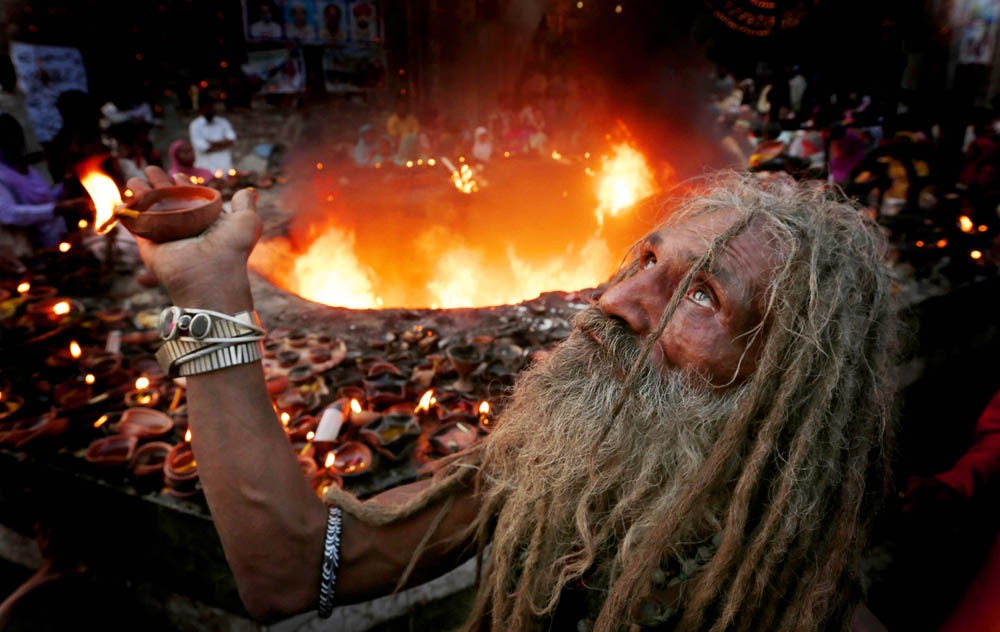
Exhilarating scenes at the recently concluded Mela Chiraghan

Zarina Bibi, an elderly pilgrim at the recently concluded Mela Chiraghan, who is over from Kasur, claims to be an avid follower of the sixteenth-century Punjabi Sufi poet and saint Shah Hussain, alias Madhu Lal Hussain. She says she has never missed the festival for as long as she remembers.
"When I lend my ears to his kafis, I feel spiritually elevated," she is overcome with emotion as she speaks.
Traditionally, held in the last week of March every year, at Shah Hussain’s shrine in Baghbanpura, on the outskirts of Lahore, adjacent to the Shalimar Gardens, Mela Chiraghan (or Festival of Lights) has been a fixture with the devotees through history. Though, a presidential order in 1958 put a temporary stop on the festival.
More than 400 years on, the ‘alao’ (or bonfire) still attracts hordes of ‘malangs’ who dance wildly around it, to the dhol beats. It’s a dance of trance (or dhamal), a state of self-denial in which one seeks the Greater Love.
Other highlights include mesmerising illuminations, recitation of kafis -- a genre of spiritual poetry, makeshift food stalls and toy shops, and boat swings.
Perhaps, the most exhilarating is the sight of the crowd of people flocking together in a united wish to fulfil their spiritual and worldly aspirations.
This year, too, the festival was observed with great zeal. The shrine of Shah Hussain was well-lit and festooned with ribbons, flags and garlands of flamboyant colours. The tomb’s façade, its arches, corridor, marble pavements, courtyard, patio and ‘langar khana’ (a place where food is distributed for charity) exuded a sense of serenity.
The Mela venue had a great sprawl that reached beyond the confines of the shrine and spilled on to the Main GT Road and adjoining streets. Massive banners with welcome signs greeted everybody. The festivity was simply infectious.
Hours before the Mela Chiraghan officially commenced, the devotees had started pouring in, apparently from different parts of Punjab, to pay their tributes to the legendary poet and saint. They varied in age and gender.
Over the next three days of the festival, the pilgrims continued to grow. The attendance would peak at night. The devotees lighted the fire at ‘alao,’ feeding it constantly with wax candles and oil and mud lamps (chiragh).
The show of fire drew everyone’s attention. Despite the stampede, the visitors’ yearning to catch a glimpse of the sight was worth a look.
The lighting of the lamps is traditionally associated with wish-making. Even those whose wishes have come true perform the ‘ritual’ in order to avoid a mishap. Some devotees even touch the fire with their hands.
Shabana Akhter, a young lady, had wished for a baby boy two years ago while visiting the shrine. She had also vowed to toss 200 candles into the fire in the belief that it would remove any bad omen whatsoever. "This year, my wish was fulfilled," she said. "I am here to honour my pledge."
Shujaat Ali, a student of engineering at a local university, termed the ritual as "contrived."
His argument was, "Hazrat Shah Hussain never lighted a fire nor did he ask the people to do so in order to have their wishes fulfilled."
A part of the shrine was reserved for the throngs of malangs and their disciples who were typically sporting long, tussled hair; rosaries of ornaments of religious value, dusty robes and ankle bells.
The pilgrims would sit around the malangs, believing them to be the most ‘rewarded’ because they have devoted their lives to the service of God, above their personal needs and wishes.
The dhamal had the malangs spinning their heads and rattling their ankle bells incessantly.
Baba Jaggu, a malang from Sahiwal, said he had left his home and family 15 years ago, in his "quest for the truest love." Since then, he has been coming to the shrine to get the blessings of Shah Hussain.
Another malang said he had rejected all material pursuits. "The woe-begone approach us and the great Shah Hussain salvages them," he asserted.
The devotees were holding green coloured ‘holy’ sheets meant to collect charity.
As the langar continued all day, the enthusiasts crowded the place and enjoyed free meals and drink. Basit Haq, a local mason, said the food (from the langar) was held in high esteem. "If you have it, you are blessed."
The most sacred site at the shrine was indeed the grave of Shah Hussain and also that of his disciple Madhu Lal. The pilgrims lay floral wreaths on the graves. They also offered requiem.
The last day of the Mela was dedicated to women and offered swing boat ride, among other activities.
The most popular food item at the stalls was katlama, an oval-shaped loaf of bread sprinkled with spices and deep-fried.
According to an estimate, more than 0.6 million people attended the Mela Chiraghan this year. The number has gone up by 20 per cent over the years.
Circus, regarded as an integral part of the Mela, could not take place this year, for reasons best known to administration.